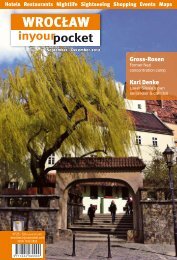SARAJEVO - In Your Pocket
SARAJEVO - In Your Pocket
SARAJEVO - In Your Pocket
Create successful ePaper yourself
Turn your PDF publications into a flip-book with our unique Google optimized e-Paper software.
32 What to see<br />
Morica Han B-4, Saraci 77. Morica Han dates from<br />
1551 and is the best preserved inn in Sarajevo. Its beautiful<br />
cobbled courtyard is surrounded by old stables and store<br />
houses and lodging rooms upstairs. Now home to a<br />
restaurant and a youth organisation. There is also a carpet<br />
shop with stacks of rugs where stables used to be. You‘re<br />
free to stroll around, have a coffee or something to eat, or<br />
buy a beautiful carpet.<br />
National Library B-4, Mustaj-pasin mejdan, tel.<br />
(+387) 33 275 301, fax (+387) 33 218 431, nubbih@<br />
nub.ba, www.nub.ba. The National Library, once the town<br />
hall and now called Vijecnica, was constructed by Alexander<br />
Wittek in 1896. On 25 August 1992 a shell fired from the<br />
lines of the Serbian forces besieging Sarajevo wiped out a<br />
large part of the Bosnian literary heritage that was kept in<br />
the building - over two million books and documents went<br />
up in flames. As the plaque outside cautions, ‘Do not forget,<br />
remember and warn!’ Restoration work is still ongoing and<br />
Vijecnica is almost entirely boarded-up, although a stroll<br />
around the outside of this battered but still beautiful building<br />
is well worth the walk and art exhibitions are held from time<br />
to time in the shattered interior.<br />
Orthodox Cathedral B-4, Zelenih Beretki bb. <strong>In</strong>side<br />
the large, wonderfully cool and calming interior of the<br />
Church of the Most Holy Mother of God, which dates from<br />
1868, are large iconostases holding icons made in Russia,<br />
installed here by Russian masons sent by Tsar Alexander<br />
II. As a proof of religious tolerance, Sultan Abdul Aziz, and<br />
the Prince of Serbia donated 500 gold ducats towards the<br />
construction of the building. Serb forces shot up their own<br />
church during the war and the Greek government is now<br />
involved in helping restore the damage. Once you feel that<br />
you’ve soaked up enough of the spiritual you can wander<br />
outside this imposing multi-domed, pale mustard-colored<br />
building and watch the men playing chess on the giant board<br />
just outside on the square.<br />
Orthodox Cathedral<br />
Get ready to haggle<br />
Orthodox Church B-4, Mula Mustafe Bašeskije<br />
59. Sitting between the mosques is the ancient Serbian<br />
Orthodox church of St. Michael the Archangel, which dates<br />
from medieval times: the foundations and the unusual<br />
arcade structures are even early Christian, from the 5th and<br />
6th century. A tad unprepossessing outside, the interior is<br />
beautiful with gilded icons and a balcony lit by candles and<br />
low light, and the scent of incense in the air. <strong>In</strong>side glass<br />
cases are a few anatomical relics of saints such as bones.<br />
The current structure that dates from 1740 was ironically<br />
badly damaged by Serb shells during the siege.<br />
Sebilj B-4, . If you are already wondering how soon you can<br />
make a return visit to Sarajevo take a drink from the public<br />
fountain in Sebilj square and, according to local legend,<br />
you won’t stay away for long. Built in 1891 from a design<br />
by Czech architect Alexander Wittek, the stone and timber<br />
Moorish-style fountain is the centerpiece of the main square<br />
in the old town. You can stroll between the restaurants and<br />
souvenir shops and watch the pigeons that give the square<br />
its better-known name descend on anyone kindly or foolhardy<br />
enough to pay a mark for a cup of corn - literally birdfeed for<br />
bird food. And if you want a cup of real Bosnian coffee, here<br />
is the place to get both it and a ringside seat for watching<br />
Sarajevo stroll by.<br />
Svrzo’s House C-4, Glodina 8, tel. (+387) 33 53 52<br />
64. Svrzo’s House reflects the lifestyle of a wealthy Muslim<br />
family lifestyle during the time of the Ottoman Empire. Visitors<br />
can inspect the separate living quarters of the men, women<br />
and servants and note the spacious comfort of the rooms<br />
used for receiving and entertaining guests. The house is in<br />
an extremely well-preserved condition, especially considering<br />
that it is constructed completely from wood, a building<br />
material not commonly used in the region in relatively modern<br />
times. A quiet courtyard would have provided the occupants<br />
with a pleasant and private outdoor sitting area, as it now<br />
does for the visitor, but it is the interior that provides the<br />
most interest. QOpen 10:00 - 16:00, Sat 10:00 - 15:00.<br />
Closed Sun.<br />
Sarajevo <strong>In</strong> <strong>Your</strong> <strong>Pocket</strong> sarajevo.inyourpocket.com

















